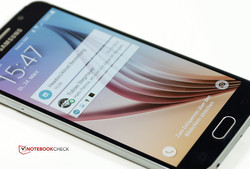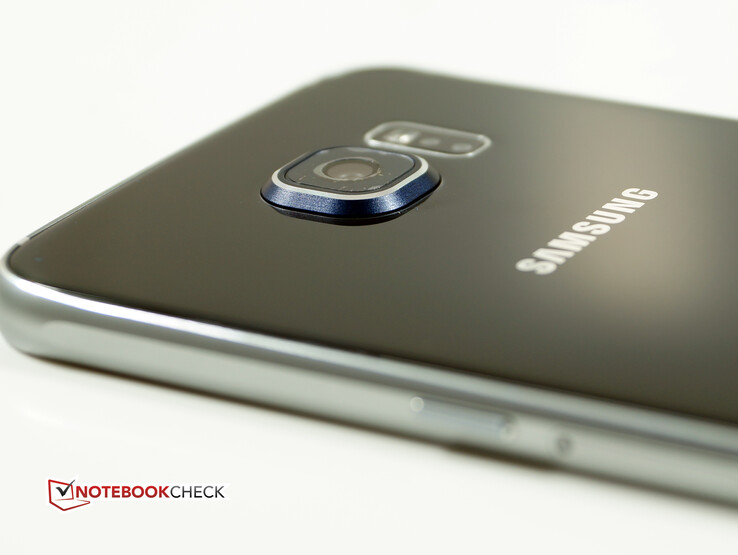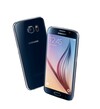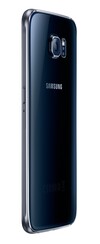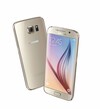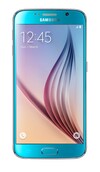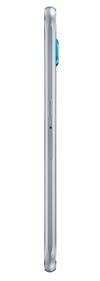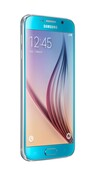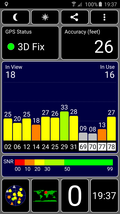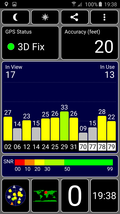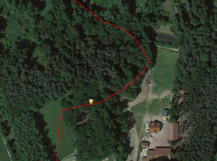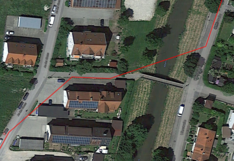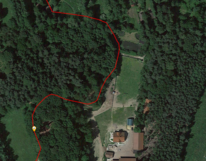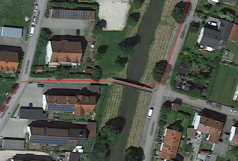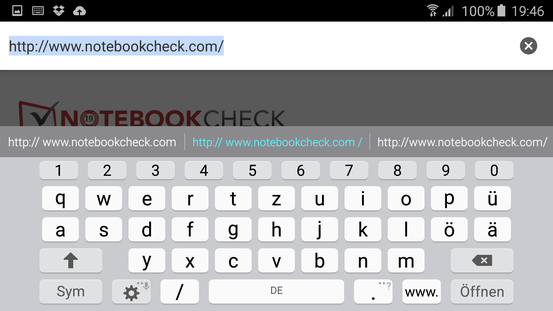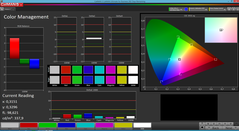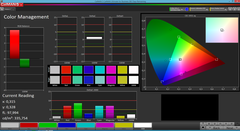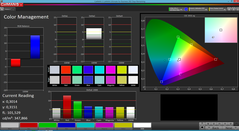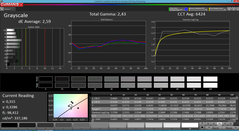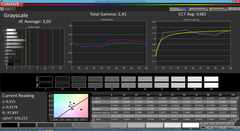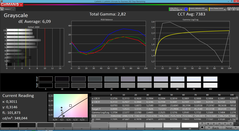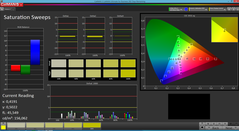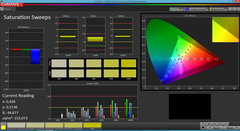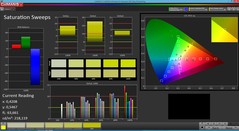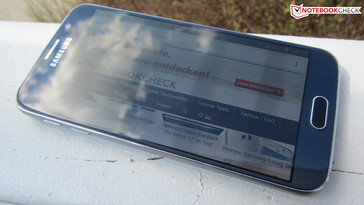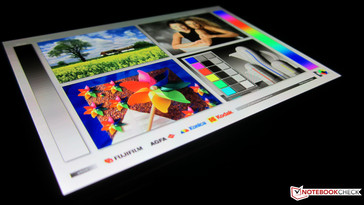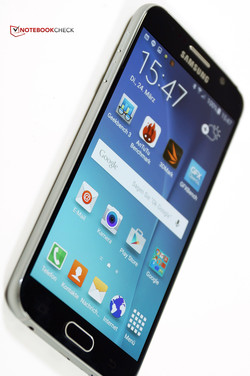Samsung Galaxy S6 Smartphone Review
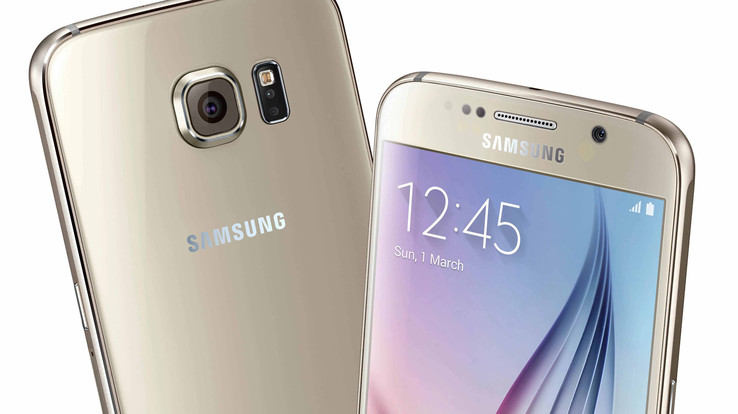
For the original German review, see here.
The Galaxy S6 is Samsung’s sixth generation of its smartphone bestseller, and once again, the latest Galaxy device from the South Korean manufacturer wants to beat the competition. Measuring 5.1 inches, the Galaxy S6 is just as large as the predecessor Galaxy S5, but Samsung has increased the resolution to 2560x1440 pixels. You can also expect a lot from the performance since the Galaxy S6 uses an octa-core SoC from Samsung itself, which is supported by no less than 3 GB of memory. What is really new is the move away from a polycarbonate chassis; you now get a case made of aluminum and glass. Whether the Galaxy S6 can beat the smartphone rivals like the Apple iPhone 6, the Sony Xperia Z3, the LG G3the HTC One M9 and obviously the predecessor Galaxy S5 was an interesting question in our preview article. Now you can read our in-depth review.
Case
No plastic, but glass and metal instead: Pick up the Galaxy S6 and you immediately notice that Samsung has put a lot of effort into the chassis of its high-end smartphone. The result of the almost perfectly built aluminum chassis with the scratch-proof Corning Gorilla Glass 4 display surface is a 5.1-inch smartphone that leaves an excellent impression, both in terms of the design as well as the haptics. It is a matter of course that the device has no problems with creaking sounds when you try to twist the case or apply a lot of pressure. Despite its comparatively large display, the Galaxy S6 is quite light (138 grams/~4.9 oz) and very slim (6.8 millimeters/~0.27 inches). You will notice the main camera at the back when your fingers glide over the surface since the sensor is slightly protruding. However, we are only talking about a couple of millimeters.
Even the best smartphone chassis is not useful in practice if the buttons are not well built or have a spongy feel. Fortunately, this is not a problem for the Galaxy S6 and we liked the buttons with their well-defined pressure points. They are also well integrated and do not clatter or produce annoying sounds. Directly below the power button at the right side of the chassis is the slot for Nano-SIM cards, which is completely flush with the case and has to be opened with a small tool. The home button under the display activates the start screen and includes a fingerprint reader. The latter can be used to unlock the device.
Connectivity
We do not expect anything but the best in all sections from a flagship smartphone, particularly in the SoC and memory equipment. And Samsung does not disappoint us: With 3 GB of RAM, you get a generous amount of memory, and the brand-new Samsung processor Exynos 7420 Octa has – as the name suggests – eight cores. The ARM Mali-T760 GPU is also a new chip. The version in the Galaxy S6 has eight clusters that run with 700 to 772 MHz each. The high-end graphics chip also supports OpenCL 1.1 and DirectX 11 as well as OpenGL ES 3.1.
However, there is another highlight besides the octa-core SoC: The Galaxy S6 supports wireless charging. Older Galaxy versions required a special back cover for this – but you do not have to customize the Galaxy S6. The wireless charging works with PMA and Qi standard and it is handy that you can also use Qi charging stations from older Galaxy devices. It also works the other way around, which means you can charge the Galaxy S5 with the Qi charging station for the Galaxy S6.
So is everything perfect? Not quite, because Samsung has dispensed with both a replaceable battery as well as a microSD card slot in the Galaxy S6. Even the smallest configuration comes with 32 GB internal storage and therefore offers a lot of space for your files, but this comes at a price. Samsung charges a pretty hefty 700 Euros (~$739) for the 32 GB version, and the configurations with 64 GB and 128 GB will cost 100 and 200 Euros (~$106 and $211) more, respectively.
Software
Just like its sibling Galaxy S6 Edge, the Galaxy S6 uses Android 5.0.2 Lollipop, which is the latest Android version at the time of this review. Once again, Samsung’s own user interface TouchWiz is included and offers some useful new features. One of these features is the Smart Manager that allows quick access to important smartphone functions like WLAN, Bluetooth or the energy-saving modes. Samsung has also installed some apps on the Galaxy S6. They are generally useful and cover all the basics and we are not speaking of bloatware. Amongst others, the list of apps includes several Google apps like Chrome, Gmail, Maps and Google+ as well as social media apps like Instagram and Facebook. You also get the familiar Samsung apps S Voice (voice control), S Health (fitness) and S Planner (calendar).
Communication & GPS
As befits a flagship smartphone, the Galaxy S6 does not make any compromises in terms of the communication features. Instead, the user gets nearly everything that is available. This includes: Quad-band GSM (850/900/1800/1900 MHz), quad-band UMTS (850/900/1900/2100 MHz) and even octa-band LTE (700/800/850/900/1800/1900/2100/2600 MHz). If you have a corresponding data plan, the smartphone can reach transfer rates of up to 300 Mbps (download) and 50 Mbps (upload) in LTE networks. According to the manufacturer, you can still reach good speeds of up to 42 Mbps (download) and 5.76 Mbps (upload) via UMTS. Short-range wireless data transfers with the Galaxy S6 are possible via Bluetooth 4.1, NFC, as well as WLAN 802.11a/b/g/n/ac, which worked well both in 2.4 and 5 GHz networks during our review. The only issue is the USB port, since Samsung has only implemented a USB 2.0 port instead of USB 3.0.
The navigation features are very good. You can locate your current position via GPS and GLONASS, which worked very reliably and quickly. The Samsung displayed the correct position almost always on our 8.5 kilometers (~5.3 miles) bicycle test track and just took some "shortcuts", so the overall track length is slightly shorter compared to our professional navigation device, the Garmin Edge 500.
Telephone & Voice Quality
There is no criticism for the phone qualities: Neither the voice nor the sound quality of the Galaxy S6 revealed any issues during our review period, which applies to calls to other smartphones as well as landlines. Established connections were stable and there were no distortions, signal noise or other issues. It is possible to assign colors for contacts in the Phone app, which means the display lights up in the corresponding color when the contact calls.
Cameras & Multimedia
A major issue ahead of the S6 presentation was the camera equipment. Once again, Samsung wants to set new records for the picture quality. While the front camera has a decent resolution of 5 MP, the Koreans use a main camera with a 16 MP sensor. However, this is nothing special for a high-end smartphone. An aperture of f/1.9 on the other hand is special. This means we can hope for sharper and better-exposed pictures in low-light situations compared to the predecessor Galaxy S5 (aperture f/2.2). As with the Apple iPhone 6 or the Nokia Lumia 1020, you also get an optical image stabilizer, which is supposed to improve videos and pictures. Great: If you want to take a quick picture, you just have to press the Home button twice. This launches the camera app.
The Samsung Galaxy S6 can meet the high expectations in our review. Pictures are very sharp with rich colors, while remaining natural. Bright-dark contrasts are captured well and even sunlight from the side is no problem for the sensor. The picture quality of the Galaxy S6 does not fall behind the current top devices of Apple iPhone 6 and Nokia Lumia 1020, neither in respect of the pictures nor the videos. Depending on the photographing environment, one of the devices can have the edge over the others. Nevertheless, in the end it does not matter how closely you look at the results, one thing is certain: The Galaxy S6 is currently one of the best camera smartphones.
Accessories & Warranty
Samsung ships the Galaxy S6 with a Micro USB cable, a modular power adaptor and headphones as well as a quick-start guide. Additional protective covers are listed on the website of the manufacturer and you have the choice between several types of covers (with or without a "window" at the front, for example), but they are anything but cheap with starting prices of 30 Euros (~$32). The Galaxy S6 has a two-year warranty against material and build quality issues, but replaceable parts like the battery, the headset, the modular PSU and the USB cable are only covered for six months.
Input Devices & Handling
Powered by a fast octa-core SoC, the Galaxy S6 is impressive with very short response times and you can feel that right away. As befits a high-end device, there are no waiting times, even after you boot the smartphone. Selected menu items or settings appear instantaneously, scrolling is buttery smooth and the display content is quickly rotated when the corresponding auto-function is activated. The Galaxy S6 can recognize up to 10 finger inputs simultaneously and impresses with extremely precise controls. Inputs of texts and URLs via the virtual keyboard are no problem. The keyboard also has an additional row with numbers, which means you do not have to switch between keyboard layouts. If the fingerprint reader is active, you just have to put your finger on the home button for a very short time (we are talking about less than a second) to unlock the smartphone. This procedure takes much longer on the iPhone 6.
Display
Samsung’s magical solution for the display is often called Super-AMOLED. This technology impresses with extreme contrasts, pure black and perfect viewing angles. You immediately understand why Samsung favors the OLED technology if you have ever used a tablet from Samsung’s Galaxy Tab S-series next to an Apple iPad. The sixth generation of Samsung’s flagship device also features the highest display resolution so far with 2550x1440 pixels. This is an increase of 56% compared to the Full HD predecessor Galaxy S5, and blurry elements or visible pixels should not be a problem when you consider the pixel density of 557 ppi.
With an average brightness of 345 cd/m², the display of the Galaxy S6 is bright enough for every indoor scenario. Thanks to the OLED technology, there are no doubts about the deep blacks and the theoretically infinite contrast. One small criticism: The brightness distribution is not that great with 89%. On the other hand, the Galaxy S6 produces great and vivid colors.
| |||||||||||||||||||||||||
Brightness Distribution: 89 %
Center on Battery: 335 cd/m²
Contrast: ∞:1 (Black: 0 cd/m²)
ΔE ColorChecker Calman: 2.51 | ∀{0.5-29.43 Ø4.78}
ΔE Greyscale Calman: 2.59 | ∀{0.09-98 Ø5}
Gamma: 2.43
CCT: 6424 K
| Samsung Galaxy S6 Mali-T760 MP8, Exynos 7420, 32 GB UFS 2.0 Flash | Apple iPhone 6 PowerVR GX6450, A8, 128 GB eMMC Flash | HTC One M9 Adreno 430, 810 MSM8994, 32 GB eMMC Flash | LG G3 Adreno 330, 801 MSM8974AC, 16 GB eMMC Flash | OnePlus One Adreno 330, 801 MSM8974AC, 64 GB eMMC Flash | Sony Xperia Z3 Adreno 330, 801 MSM8974AC, 16 GB eMMC Flash | Samsung Galaxy S5 Adreno 330, 801 MSM8974AC, 16 GB eMMC Flash | |
|---|---|---|---|---|---|---|---|
| Screen | -4% | -46% | -41% | -55% | -64% | -37% | |
| Brightness middle (cd/m²) | 335 | 520 55% | 474 41% | 417 24% | 423 26% | 702 110% | 358 7% |
| Brightness (cd/m²) | 345 | 511 48% | 458 33% | 395 14% | 408 18% | 671 94% | 364 6% |
| Brightness Distribution (%) | 89 | 88 -1% | 85 -4% | 89 0% | 83 -7% | 90 1% | 82 -8% |
| Black Level * (cd/m²) | 0.61 | 0.4 | 0.96 | 0.54 | 0.72 | ||
| Colorchecker dE 2000 * | 2.51 | 3.92 -56% | 6.32 -152% | 5.67 -126% | 5.56 -122% | 8.92 -255% | 5.28 -110% |
| Greyscale dE 2000 * | 2.59 | 4.33 -67% | 6.36 -146% | 5.66 -119% | 7.55 -192% | 9.59 -270% | 4.65 -80% |
| Gamma | 2.43 91% | 2.46 89% | 2.43 91% | 2.53 87% | 2.33 94% | 2.75 80% | 2.48 89% |
| CCT | 6424 101% | 7384 88% | 8218 79% | 7741 84% | 7624 85% | 9408 69% | 7690 85% |
| Contrast (:1) | 852 | 1185 | 434 | 783 | 975 | ||
| Color Space (Percent of AdobeRGB 1998) (%) | 58.81 | 59 |
* ... smaller is better
A closer look at the AMOLED display of the Samsung Galaxy S6 with an X-Rite i1Pro 2 Spectrophotometer and the CalMAN software shows that the objective picture quality of the smartphone is very good as well. The standard display mode “Simple” has particularly good values that are very close to the ideal values for the colors (DeltaE of 2.51) as well as the grayscale (DeltaE of 2.59). The same applies to the color temperature, which just barely deviates from the ideal value with 6424 K. The two display modes "AMOLED Picture" and "AMOLED Cinema", which are designed for the playback of pictures and videos, show bigger deviations, but they were intentional.
The luminance value of the Galaxy S6 does not seem to be very impressive, but this impression is misleading. The Samsung smartphone actually has some brightness reserves. If the brightness sensor is active, the smartphone can further increase its luminance, so it is not a problem to use it outdoors. According to Samsung, the brightness can reach up to 600 cd/m², which seems to be a realistic value. A big part of the outdoor capabilities is due to the AMOLED display, which provides excellent viewing angles even from extreme positions. The only problem for the visibility can be the very glossy display.
Performance
At the heart of the Galaxy S6 is an Exynos 7420 Octa SoC with eight cores, which is Samsung’s first chip with a 14 nm manufacturing process. Four cores are based on the Cortex A53 and four on the Cortex A57 architecture. The A57 cores run with up to 2.1 GHz and handle the demanding computing tasks if necessary. The A53 cores are a little slower with 1.5 GHz and are still supposed to provide a decent amount of performance, but in combination with lower power consumption. The SoC supports 64-bit as well, which actually results in some small advantages in tests like AnTuTu v5 64-bit under Android Lollipop. The GPU is a Mali-T760 from ARM.
The Samsung Galaxy S6 can take the performance crown in almost every benchmark. Only the HTC One M9 and the Apple iPhone 6 can keep up, but the latter only in two disciplines. We can only see a significant advantage for the top device from Apple in Geekbench 3 and SunSpider 1.0, but if falls behind the Galaxy S6 in every other test. Therefore, the biggest rival is the HTC One M9. Both top devices are neck and neck in the CPU and GPU tests, but the Galaxy has a noticeable advantage in respect of the browser as well as the storage performance.
| Geekbench 3 | |
| 32 Bit Single-Core Score (sort by value) | |
| Samsung Galaxy S6 | |
| Apple iPhone 6 | |
| LG G3 | |
| OnePlus One | |
| Samsung Galaxy S5 | |
| Sony Xperia Z3 | |
| HTC One M9 | |
| 32 Bit Multi-Core Score (sort by value) | |
| Samsung Galaxy S6 | |
| Apple iPhone 6 | |
| LG G3 | |
| OnePlus One | |
| Samsung Galaxy S5 | |
| Sony Xperia Z3 | |
| HTC One M9 | |
| AnTuTu v5 - Total Score (sort by value) | |
| Samsung Galaxy S6 | |
| Apple iPhone 6 | |
| LG G3 | |
| OnePlus One | |
| Sony Xperia Z3 | |
| HTC One M9 | |
| 3DMark | |
| 1280x720 offscreen Ice Storm Unlimited Score (sort by value) | |
| Samsung Galaxy S6 | |
| Apple iPhone 6 | |
| LG G3 | |
| OnePlus One | |
| Samsung Galaxy S5 | |
| Sony Xperia Z3 | |
| HTC One M9 | |
| 1280x720 offscreen Ice Storm Unlimited Graphics Score (sort by value) | |
| Samsung Galaxy S6 | |
| Apple iPhone 6 | |
| LG G3 | |
| OnePlus One | |
| Samsung Galaxy S5 | |
| Sony Xperia Z3 | |
| HTC One M9 | |
| 1280x720 offscreen Ice Storm Unlimited Physics (sort by value) | |
| Samsung Galaxy S6 | |
| Apple iPhone 6 | |
| LG G3 | |
| OnePlus One | |
| Samsung Galaxy S5 | |
| Sony Xperia Z3 | |
| HTC One M9 | |
| GFXBench 3.0 | |
| on screen Manhattan Onscreen OGL (sort by value) | |
| Samsung Galaxy S6 | |
| Apple iPhone 6 | |
| LG G3 | |
| OnePlus One | |
| Samsung Galaxy S5 | |
| Sony Xperia Z3 | |
| HTC One M9 | |
| 1920x1080 1080p Manhattan Offscreen (sort by value) | |
| Samsung Galaxy S6 | |
| Apple iPhone 6 | |
| LG G3 | |
| OnePlus One | |
| Samsung Galaxy S5 | |
| Sony Xperia Z3 | |
| HTC One M9 | |
The browsing performance is usually a clear strength of iOS devices from Apple. However, the performance of the Galaxy S6 beats even the dominant iPhone. Google Octane v2, for example, returns 8518 points for the S6, which is the best result we have measured so far. Samsung also has an advantage in the complex WebXPRT 2013. Apple on the other hand, can strike back in Browsermark and SunSpider. The results of the S6 – and even more so the subjective browsing performance – are still excellent.
| Octane V2 - Total Score (sort by value) | |
| Samsung Galaxy S6 | |
| Apple iPhone 6 | |
| LG G3 | |
| LG G3 | |
| Samsung Galaxy S5 | |
| Sony Xperia Z3 | |
| HTC One M9 | |
| Sunspider - 1.0 Total Score (sort by value) | |
| Samsung Galaxy S6 | |
| Apple iPhone 6 | |
| LG G3 | |
| LG G3 | |
| OnePlus One | |
| Samsung Galaxy S5 | |
| Sony Xperia Z3 | |
| HTC One M9 | |
| Browsermark - 2.1 (sort by value) | |
| Samsung Galaxy S6 | |
| Apple iPhone 6 | |
| LG G3 | |
| LG G3 | |
| OnePlus One | |
| HTC One M9 | |
| WebXPRT 2013 - Overall (sort by value) | |
| Samsung Galaxy S6 | |
| Apple iPhone 6 | |
| LG G3 | |
| LG G3 | |
| OnePlus One | |
| Samsung Galaxy S5 | |
| Sony Xperia Z3 | |
| HTC One M9 | |
* ... smaller is better
A real highlight of the Samsung Galaxy S6 is the performance of the internal flash storage. None of the smartphones that we have reviewed so far can keep up with the top device from South Korea. 319 MB/s for sequential reads and around 140 MB/s for writes are almost from another galaxy. Only the OnePlus One can at least keep up with the write speeds of the S6. The performance drops significantly with 4K blocks, but the results are still outstanding. With 80 MB/s (read) and 19.9 MB/s (write), the Samsung flagship is in a class of its own.
| AndroBench 3-5 | |
| Random Read 4KB (sort by value) | |
| Samsung Galaxy S6 | |
| LG G3 | |
| OnePlus One | |
| Samsung Galaxy S5 | |
| Sony Xperia Z3 | |
| HTC One M9 | |
| Random Write 4KB (sort by value) | |
| Samsung Galaxy S6 | |
| LG G3 | |
| OnePlus One | |
| Samsung Galaxy S5 | |
| Sony Xperia Z3 | |
| HTC One M9 | |
| Sequential Read 256KB (sort by value) | |
| Samsung Galaxy S6 | |
| LG G3 | |
| OnePlus One | |
| Samsung Galaxy S5 | |
| Sony Xperia Z3 | |
| HTC One M9 | |
| Sequential Write 256KB (sort by value) | |
| Samsung Galaxy S6 | |
| LG G3 | |
| OnePlus One | |
| Samsung Galaxy S5 | |
| Sony Xperia Z3 | |
| HTC One M9 | |
Games
The combination of the octa-core processor Exynos 7420 Octa and ARM Mali-T760 GPU does not only result in excellent benchmark results, but you also get smooth frame rates all the time. So far, no Android game could really stress the Samsung flagship. Both the position sensor and accelerometer worked without problems in every current game that we started on the smartphone.
Emissions
Temperature
The Galaxy S6 does not break a sweat when it runs games or benchmarks. Even maximum load for more than one hour only results in 35.6 °C (96.08 °F), so it gets just lukewarm. We can only measure temperatures of around 28 °C (82.4 °F) while idling.
(+) The maximum temperature on the upper side is 35.6 °C / 96 F, compared to the average of 35.2 °C / 95 F, ranging from 21.9 to 247 °C for the class Smartphone.
(+) The bottom heats up to a maximum of 35.9 °C / 97 F, compared to the average of 34 °C / 93 F
(+) In idle usage, the average temperature for the upper side is 28.4 °C / 83 F, compared to the device average of 32.9 °C / 91 F.
Speakers
The speaker of the Galaxy S6 is located at the bottom edge. It lacks powerful bass, but medium and high tones could be more precise. However, it is loud enough, and there are no distortions. Verdict: Not a top-notch performance, but average for a smartphone.
Energy Management
Power Consumption
The battery capacity of 2550 mAh is quite generous, but it cannot be replaced. However, the low consumption values in all scenarios let us hope for long battery runtimes. With a maximum of 1.2 watts while idling, the Galaxy S6 is just as frugal as under maximum load, where we can measure up to 6.8 watts. As we have mentioned before, the Samsung also supports wireless charging and has a quick-charge feature, which really deserves its name. It just took 1 hour and 20 minutes before the battery was fully charged.
| Off / Standby | |
| Idle | |
| Load |
|
Key:
min: | |
Battery Runtime
Under maximum load, the Galaxy S6 runs longer than any other comparison device, lasting 4 hours and 38 minutes and outclasses the iPhone 6 (2 hours 8 minutes) in particular. The Galaxy S6 can beat the iPhone 6, the HTC One M9 and the LG G3 in the realistic WLAN test. Much more enduring than the Galaxy S6 is the Samsung Galaxy S5 (10 hours 13 minutes), the Sony Xperia Z3 (11 hours 12 minutes) and especially the OnePlus One (18 hours 46 minutes). The runtime of the Galaxy S6 is a bit shorter with almost 8 hours in our new WLAN test, which is more demanding and consumes more power than the previous version. Once again, the iPhone 6 is worse, and the OnePlus One is miles ahead.
| Samsung Galaxy S6 Mali-T760 MP8, Exynos 7420, 32 GB UFS 2.0 Flash | Apple iPhone 6 PowerVR GX6450, A8, 128 GB eMMC Flash | HTC One M9 Adreno 430, 810 MSM8994, 32 GB eMMC Flash | LG G3 Adreno 330, 801 MSM8974AC, 16 GB eMMC Flash | OnePlus One Adreno 330, 801 MSM8974AC, 64 GB eMMC Flash | Sony Xperia Z3 Adreno 330, 801 MSM8974AC, 16 GB eMMC Flash | Samsung Galaxy S5 Adreno 330, 801 MSM8974AC, 16 GB eMMC Flash | |
|---|---|---|---|---|---|---|---|
| Battery runtime | -31% | -14% | -23% | 53% | -18% | -2% | |
| WiFi (h) | 9.6 | 8.8 -8% | 9.6 0% | 7.5 -22% | 18.8 96% | 11.2 17% | 10.2 6% |
| WiFi v1.3 (h) | 7.9 | 5.8 -27% | 16.1 104% | ||||
| Load (h) | 4.6 | 2.1 -54% | 3.9 -15% | 3.5 -24% | 2.7 -41% | 2.2 -52% | 4.2 -9% |
| H.264 (h) | 9.9 | 7 | 4.6 | 14.9 | 11.4 | 9.3 |
Pros
Cons
Verdict
The Samsung Galaxy S6 is a big step ahead in many ways. First of all, you get a classy chassis made of metal and glass, which has an almost perfect build quality and can impress with its light weight and compact dimensions. The South Koreans have also increased the performance significantly. The engineers from Samsung combine the highest performance with moderate power consumption in their own 64-bit SoC with eight cores. As a result, hardly any other high-end device can keep up with the S6. The main camera is impressive with its high light sensitivity and great picture quality, and the Super AMOLED display is in a league of its own.
Only two things prevent the Galaxy S6 from being the perfect smartphone: a microSD slot as well as a replaceable battery.
So is it enough for the smartphone crown? Yes, because ultimately there are just two aspects of the Galaxy S6 we can criticize: The missing microSD slot – although the smallest configuration of the S6 already has 32 GB internal storage, it will be filled up eventually. Another flaw with the South Korean device is the non-replaceable battery.
The Samsung Galaxy S6 can take the top spot among the high-end competition for now, but it shares the spot with its predecessor the Galaxy S5 and the Sony Xperia Z3. Rivals like the Apple iPhone 6 or the HTC One M9 are just one or two percent behind – we do not even want to talk about a real advantage. Probably there will be a clear winner with the Samsung Galaxy S6 Edge. The top smartphone with a rounded display has already left a great impression in our preview.
Samsung Galaxy S6
- 04/07/2015 v4 (old)
Manuel Masiero




